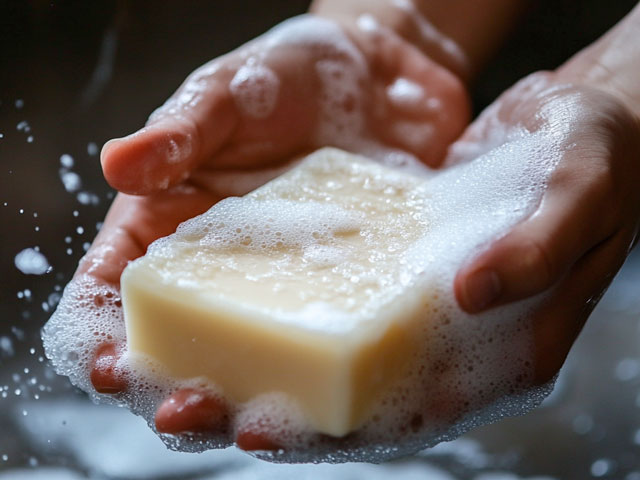How Does Soap Work?

How often do you really think about soap? Really?
What's more so is, how often do you really think about the science behind soap? You see, soap is a fascinating blend of science and everyday life that often goes unnoticed. Whether it's washing your body, the dishes in your sink, or your pet, you're often not thinking about soap. Nor are you thinking about the science behind how soap works. At least not at the molecular level.
At its core, soap is designed to break down dirt and grease, making it easier to wash away and remove from whatever you're trying to remove it from. Its unique structure allows it to interact with both water and oil, effectively lifting away unwanted substances. That's because soap is a surfactant that removes dirt and grease through its unique molecular structure.
Soap is composed mainly of fatty acids and the salts of those fatty acids. It has a hydrophilic (water-attracting) end and a hydrophobic (water-repellent) end. When used, the hydrophobic ends bind to oils and dirt, while the hydrophilic ends interact with water, forming micelles that encapsulate and wash away grime. You know, like the soap scum in your tub. The process of "cleaning" starts when soap is applied to a surface.
Some of the Science Behind The Process
Emulsification Process
The emulsification process is crucial for soap's cleaning action. Soap molecules form micelles when mixed with water. Within these micelles, hydrophobic tails trap grease while hydrophilic heads interact with water. This arrangement allows oils and dirt to become suspended in water, preventing them from re-adhering to surfaces. As I rinse, the micelles carry away trapped dirt, ensuring a thorough clean.
What Are Micelles in Soap?
Micelles are tiny clusters formed when soap molecules bind together with dirt and grease. The hydrophobic ends attach to the unwanted substances, while the hydrophilic ends interact with water, allowing these micelles to be rinsed away, resulting in cleaner surfaces.
How Soap Interacts with Water
Soap’s interaction with water plays a crucial role in cleansing. When soap dissolves in water, it reduces the surface tension, allowing the water to spread and penetrate surfaces better. The hydrophilic ends of soap molecules bond with water molecules, creating a connection that enhances the removal of oils and dirt. This unique interaction enables micelles to form, encapsulating particles and ensuring they don’t return to the surface. As rinsing occurs, the properties of soap facilitate the removal of contaminants, resulting in clean surfaces.
You know this (kind of?) as lathering up, say in the shower. Or, washing your hands at the sink. The latter of which has real guidelines from the CDC.
Benefits of Using Soap
Using soap offers numerous advantages for personal hygiene and overall health.
- Effective Cleaning: Soap effectively removes dirt, grease, and germs from skin surfaces. The surfactant properties of soap allow it to break down oils and bind to dirt, ensuring thorough cleansing.
- Germ Reduction: Soap significantly reduces the presence of pathogens on skin. When used with water, soap dislodges bacteria and viruses, minimizing the risk of infection and illness.
- Moisturizing Properties: Many soaps contain moisturizing agents that hydrate the skin. Ingredients like glycerin and natural oils help maintain skin moisture, preventing dryness.
- Variety of Formulations: Soap is available in a range of types and formulations. From liquid soaps to bar soaps, consumers can choose products suited for specific skin types and preferences, including antibacterial options.
- Environmental Impact: Many soaps are biodegradable and derived from natural ingredients. This eco-friendly characteristic makes soap a sustainable option for personal care.
- Cost-Effective: Soap is an affordable cleansing option. Its widespread availability and various price points make it accessible to most consumers without sacrificing quality.
- Pleasant Fragrance: Many soap products provide a pleasant scent, enhancing the washing experience. Fragrances, whether natural or synthetic, leave a refreshing aroma on the skin.
- Cleansing Tools: Soap works well with various cleansing tools, including washcloths and loofahs. These tools aid in exfoliating the skin while enhancing soap's effectiveness during cleansing.
Frequently Asked Questions
What benefits does soap provide for personal hygiene?
Soap effectively cleans, reduces germs, and often contains moisturizing agents like glycerin and natural oils. Regular use promotes cleanliness, supports skin health, and contributes to overall well-being, making it essential for personal hygiene.
Are there different types of soap available?
Yes, there are various soap formulations tailored to different skin types and preferences. Options include eco-friendly soaps, moisturizing varieties, and those with appealing fragrances, providing a range of choices for consumers.
One of our favorites is Castile Soap. Curious? Learn about the benefits of Castile Soap
Is soap safe to use?
For the most part, yes, soap is safe to use. Different soaps have different uses, and thus different levels of what is considered safe. For instance, Castile Soap is pretty much safe to use. Turmeric Soap mostly as well. Reading product labels and knowing your predisposed allergic responses should enable you to avoid any problematic ingredients when it comes to picking out soaps at the store.
This includes soap in bar form along with common household dish soaps. Even Dawn Dish Soap has been reported to be safe for dogs to use.
The TOP 5 Best Dr. Squatch Soaps
Super fans of good ol' Dr. Squatch and their lineup of...